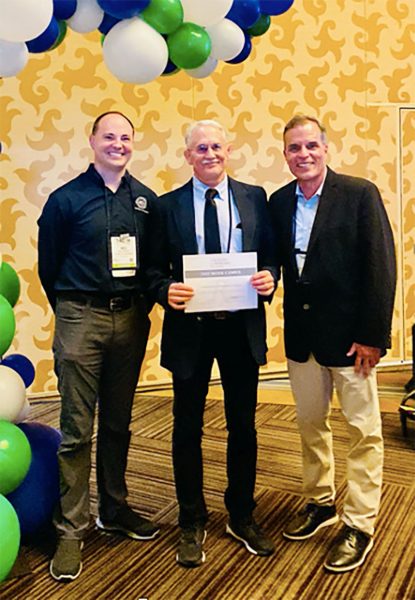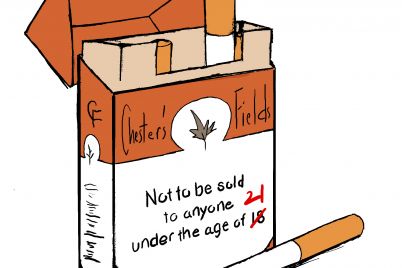
WCC biology professor Marvin Boluyt (center) accepts a Silver Award from Exercise is Medicine founder, Robert Sallis, and Exercise is Medicine on Campus co-chair, Neil Peterson, at the American College Sports Medicine National Meeting in San Diego in June 2022. Courtesy of Marvin Boluyt.
By Willow Symonds
Staff Writer
While on campus, students and staff may notice fliers and human-sized posters promoting “To the Moon.” Students may also notice WCC’s online forms, no matter the main topic, include questions about their exercise habits. What do these two incidents have in common?
The simple answer: Biology professor Marvin Boluyt implemented both of these into WCC this school year. The longer answer involves a global organization called Exercise is Medicine on Campus (EIM-OC), though they have less influence on the ‘To the Moon’ exercise initiative than one may think.
“We have an opportunity here to have a campus-wide promotion event,” Boluyt said. “It’s a unique opportunity, too, because we can compare [exercise rates among students, staff, and faculty] before and after the promotion and see: did the promotion have an effect?”
These fliers include a QR code linked directly to the website, which contains the activity log. Students and faculty can enter the amount of time they spend on physical activities each week. To prevent outside tampering, they must log into their WCC accounts to access it.
The activity log offers over 50 activities, such as walking, bicycling, skiing, and even gardening, though the possibilities don’t end here. One pickleball player has been registering their exercise under tennis, but their sport will soon be added to the list. Other activities soon to be available include ice skating, roller skating (though they do have roller blading), and skateboarding.
Exercise is Medicine on Campus co-chair Dr. Carrie Davidson encourages students and faculty to engage with To the Moon. However, she believes WCC’s new initiative could collect data in a more efficient way.
“Students need some sort of incentive [to exercise and record the results],” Davidson said. “I’m intrinsically motivated myself [to exercise], but I’m not motivated to record a bunch of stuff manually.”
Davidson also works as a fitness manager at the University of Kentucky, where students and faculty can use a platform where anyone’s wrist device – no matter if it’s Apple, Google, or another brand – automatically uploads their exercise data into the system. A downside is the price, as their school pays to use this program.
WCC does not use this platform. Instead, Communications Director Rich Rezler and other staff members created the website and activity log over the course of a year.
On the other hand, Davidson added that “each registered campus has their own autonomy to run their own programs.”
“They know what’s best to work on their college campus,” she explained. “They don’t have to get permission or run it by anyone. They might partner-up with us because they’re after the same mission.”
The incentive for students to log their exercise habits in To the Moon may be the prizes. The first tier of prizes are reserved for top performers, while the second tier will be chosen in a random drawing of each and every participant. The prizes will remain unidentified until WCC collectively travels 238,855 miles.
Anyone with school spirit will find another reason: earning the Gold award from Exercise is Medicine on Campus.
Both four-year and two-year schools apply for recognition each February in preparation for the May award ceremony. WCC first applied in 2019, after one of Marvin Boluyt’s students, Lorie Beardsley-Heyn, suggested the idea to him earlier that school year. In 2022, WCC earned a Silver Award for the fifth consecutive year.
The staff behind ‘To the Moon’ aim 2023 to be WCC’s first year earning Gold. While the ‘To the Moon’ initiative isn’t criteria for a Gold Award, Boluyt still wanted to strengthen WCC’s case when applying for EIM-OC’s top level.
This form explains the requirements for all three levels, which include Bronze, Silver, and Gold. Bronze follows the “exercise promotion” theme, while Silver needs the promotion and “exercise education.” Gold requires both of those while also ensuring their campus healthcare providers count exercise as a vital sign.
To earn Gold, campus’ healthcare providers must clinically measure students’ physical exercise during appointments. Campuses must provide screenshots of EMR (electronic medical records) or photograph other evidence of asking their student about exercise habits, and then send these to EIM-OC when applying for Gold.
Boluyt believes exercise indicates health just as much as weight and blood pressure – if not even more so. This is also why WCC questionnaires often ask students how many days they exercise in a week, along with how many minutes they exercise in a day.
Keeping track of one’s activities can increase their amount of exercise, according to a Harvard Medical School article about PLOS Medicine’s study. People who actively record their exercise are more likely to reflect on their progress and push themselves further, whether that’s running a 5k, a marathon, or racking up enough miles to reach the moon.
Having logged over 500 miles, Boluyt currently holds the number two spot on the website’s leaderboard. Most people in the ‘top 10’ are students in his Exercise Science and Kinesiology classes and fellow faculty, but he wants to change that.
“I want to reach the moon, hopefully, by the end of the semester,” Boluyt said. “We’ve got [over] 10,000 miles, but there’s still 228,000 more to go. We need to up our game.”
Once having reached the moon, he wants everyone involved to carry on and “go to Mars.”
“Mars might be a decade-long project, but that’s okay,” Boluyt said. “Why not? We shouldn’t ever stop exercising.”


